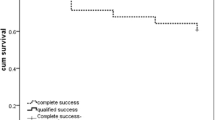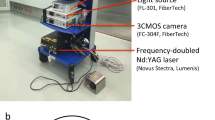Abstract
The purpose of this study was to evaluate the intraocular pressure (IOP)-lowering effect of modified goniopuncture with the 532-nm Nd : YAG selective laser trabeculoplasty (SLT) laser on eyes after deep sclerectomy with collagen implant (DSCI). This was an interventional cased series. The effects of modified goniopuncture on eyes with insufficient IOP-lowering after DSCI were observed. Goniopuncture was performed using a Q-switched, frequency-doubled 532-nm Nd : YAG laser (SLT-goniopuncture, SLT-G). Outcome measures were amount of IOP-lowering and rapidity of decrease after laser intervention. In all, 10 eyes of 10 patients with a mean age of 71.0±7.7 (SD) years were treated with SLT-G. The mean time of SLT-G after DSCI procedure was 7.1±10.9 months. SLT-G decreased IOP from an average of 16.1±3.4 mm Hg to 14.2±2.8 mm Hg (after 15 min), 13.6±3.9 mm Hg (at 1 day), 12.5±4.1 mm Hg (at 1 month), and 12.6±2.5 (at 6 months) (P<0.0125). There were no complications related to the intervention. Patients in this series achieved an average 22.5% of IOP reduction after SLT-G. The use of the SLT laser appears to be an effective and safe alternative to the traditional Nd : YAG laser for goniopuncture in eyes after DSCI, with potential advantages related to non-perforation of trabeculo-descemet's membrane (TDM).
Similar content being viewed by others
Introduction
Deep sclerectomy with a collagen implant (DSCI) has been introduced as an alternative to trabeculectomy. Its success depends on the surgical removal of the inner wall of Schlemm's canal and filtration through the created trabeculo-descemet's membrane (TDM).1, 2 This lamella, however, can either be too thick due to insufficient surgical dissection or undergo post-operative fibrosis. When intraocular pressure (IOP) is too high after DSCI, laser goniopuncture is performed to allow increased percolation of aqueous humor at the TDM.3, 4, 5, 6 Traditionally, the free-running Q-switched 1064-nm Nd : YAG laser with a spot size of 3–10 μm is used for this procedure. The 532-nm, frequency-doubled, Q-switched Nd : YAG selective laser trabeculoplasty (SLT) laser was developed to selectively target the pigmented trabecular meshwork (TM) cells while sparing adjacent microstructures from collateral thermal damage.6, 7 The purpose of our pilot study was to assess whether SLT-goniopuncture (SLT-G) can be an alternative to the traditional 1064-nm Nd : YAG laser.
Case reports
In all, 10 eyes of 10 open-angle glaucoma (OAG) patients were consecutively included in this case series. All had previously undergone DSCI with mitomycin C (MMC)1. In accordance with our clinical practice (percolation of aqueous humor at TDM considered insufficient with a shallow filtering bleb and a post-operative IOP above the individual target), these patients were scheduled for goniopuncture. Goniopuncture with the frequency-doubled 532 nm Nd : YAG laser (Selecta I, Lumenis, Yokneam, Israel) was performed using a gonio-lens (CGAL, HAAG-Streit, Koeniz, Switzerland). Using a power of 0.6–1 mJ, 6–10 shots placed next to each other, were applied. The paired t-test with Bonferroni correction was used to evaluate the effect of SLT-G and significance was set at P<0.0125.
In all, 10 eyes of 10 patients (71.0±7.7 (SD) years, seven males and three females) were treated with SLT-G after DSCI. Pre-DSCI, average vertical cup-to-disc ratio was 0.7±0.1 and visual field mean deviation was −8.9±1.8 dB. The mean time of SLT-G after DSCI procedure was 7.1±10.9 months (range: 1–32 months). The patients had a mean IOP of 20.0±4.1 before DSCI on an average of 2.9±0.8 antiglaucoma drops. No patient was on hypotensive medication before SLT-G. SLT-G achieved IOP-lowering from an average of 16.1±3.0 mm Hg to 14.2±2.8 mm Hg 15 min after SLT-G, 13.6±3.9 mm Hg after 1 day, 12.4±3.1 mm Hg after 1 week, 12.5±4.1 mm Hg after 1 month, and 12.6±2.5 (at 6 months) (P<0.0125) (Table 1). All but one patient had a decrease of IOP after SLT-G at 1 week and 1 month. This patient had a failed trabeculectomy before DSCI and with IOP remaining unchanged after SLT-G required re-introduction of antiglaucoma drops. Visual acuity was unaffected by SLT-G in all the eyes. No goniopuncture-related complications were encountered.
Discussion
This pilot study shows that the 532 nm Nd : YAG (SLT) laser can be used as an effective and safe alternative to the conventional Nd : YAG laser for goniopuncture after deep sclerectomy. We achieved an IOP-reduction of 22.5% in this series, which is comparable to reports with the conventional method.8 In four cases, a visible increase of the filtering bleb was observed on slit lamp examination following SLT-G. It is possible that SLT-G may have advantages over the conventional method. SLT-G, much like the 1064-nm Nd : YAG laser, delivers light energy in short nanosecond pulses. In the case of the SLT-G, there is less energy per pulse, a larger spot size, and hence lower fluence (mj/cm2). Due to these properties and possibly the shorter wave-length, the micro-explosions that result from photomechanical disruption are confined to the vicinity of the target and may produce less collateral damage. In our sample, the immediate IOP reduction (11.8%) seemed to be more gradual than reported with the Nd : YAG laser (up to 40%),3, 4, 5 which can be beneficial in eyes that do not need a rapid IOP-lowering. We aimed to increase outflow by modifying the TDM without creating a visible hole and thus to allow for a traditional goniopuncture to be done later on, if needed. On gonioscopy, no holes were observed in the TDM after SLT-G in all but one case. As for SLT-G, the effect of outflow alteration could theoretically be directly dependent on the degree of pigmentation of the TDM. Pigment is frequently found within the TDM, as aqueous humor flows through it after DSCI (personal observation). We hypothesize that SLT-G could allow ‘unplugging’ of the TDM even in primary OAG eyes with non-visible pigment on gonioscopy, thus improving percolation while maintaining a safe barrier between the anterior chamber and intrascleral space. As SLT-G reconditions the TDM rather than perforate it, the risk for traditional complications of goniopuncture such as iris incarceration and hypotony, however infrequent, could potentially be reduced.
A limitation of this study is that without a control group, the IOP change cannot be attributed with certainty to the intervention (vs natural history). The rapidity of the IOP change, however, suggests that the intervention is responsible. A randomized head-to-head comparison of the two lasers is therefore required to confirm our findings and to determine the long-term benefit of the procedure.

References
Mendrinos E, Mansouri K, Mermoud A, Shaarawy T . Long-term results of deep sclerectomy with collagen implant in exfoliative glaucoma. J Glaucoma 2009; 18 (5): 361–367.
Bissig A, Rivier D, Zaninetti M, Shaarawy T, Mermoud A, Roy S . Ten years follow-up after deep sclerectomy with collagen implant. J Glaucoma 2008; 17 (8): 680–686.
Mermoud A, Karlen ME, Schnyder CC, Sickenberg M, Chiou AG, Hediguer SE et al. Nd:Yag goniopuncture after deep sclerectomy with collagen implant. Ophthalmic Surg Lasers 1999; 30 (2): 120–125.
Shaarawy T, Mansouri K, Schnyder C, Ravinet E, Achache F, Mermoud A . Long-term results of deep sclerectomy with collagen implant. J Cataract Refract Surg 2004; 30 (6): 1225–1231.
Mansouri K, Shaarawy T, Wedrich A, Mermoud A . Comparing polymethylmethacrylate implant with collagen implant in deep sclerectomy: a randomized controlled trial. J Glaucoma 2006; 15 (3): 264–270.
Mansouri K, Tran HV, Ravinet E, Mermoud A . Comparing deep sclerectomy with collagen implant to the new method of very deep sclerectomy with collagen implant: a single-masked randomized controlled trial. J Glaucoma 2010; 19 (1): 24–30.
Latina MA, Park C . Selective targeting of trabecular meshwork cells: in vitro studies of pulsed and CW laser interactions. Exp Eye Res 1995; 60 (4): 359–371.
Alvarado JA, Katz LJ, Trivedi S, Shifera AS . Monocyte modulation of aqueous outflow and recruitment to the trabecular meshwork following selective laser trabeculoplasty. Arch Ophthalmol 2010; 128 (6): 731–737.
Author information
Authors and Affiliations
Corresponding author
Ethics declarations
Competing interests
The authors declare no conflict of interest.
Rights and permissions
About this article
Cite this article
Mansouri, K., Mariani, A. & Ravinet, E. Reconditioning of the trabeculo-descemet's membrane with the 532-nm Nd : YAG (SLT) laser after deep sclerectomy. Eye 25, 1655–1657 (2011). https://doi.org/10.1038/eye.2011.231
Received:
Accepted:
Published:
Issue Date:
DOI: https://doi.org/10.1038/eye.2011.231
Keywords
This article is cited by
-
Revisionsmöglichkeiten nach Kanaloplastik
Der Ophthalmologe (2016)
-
Global rates of glaucoma surgery
Graefe's Archive for Clinical and Experimental Ophthalmology (2013)



